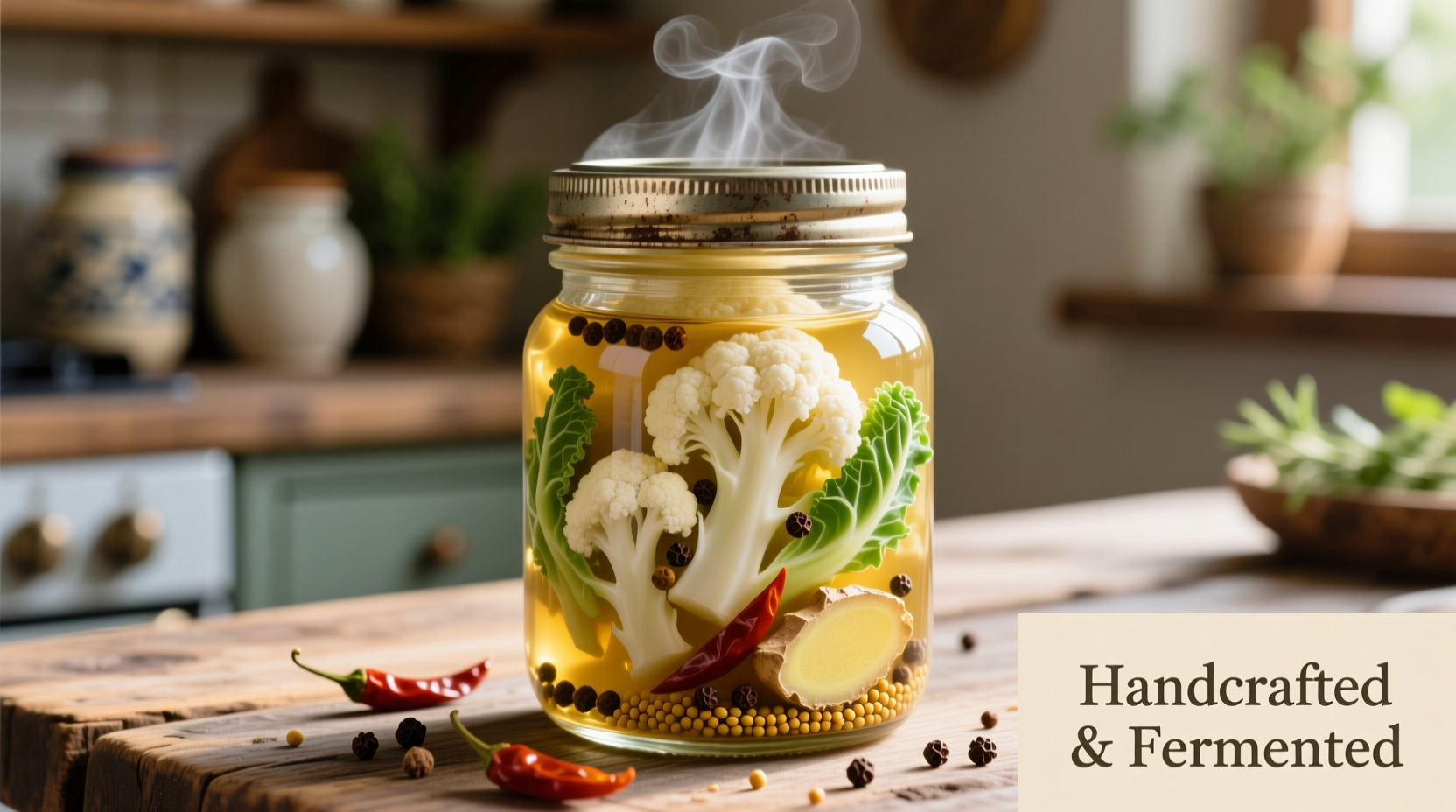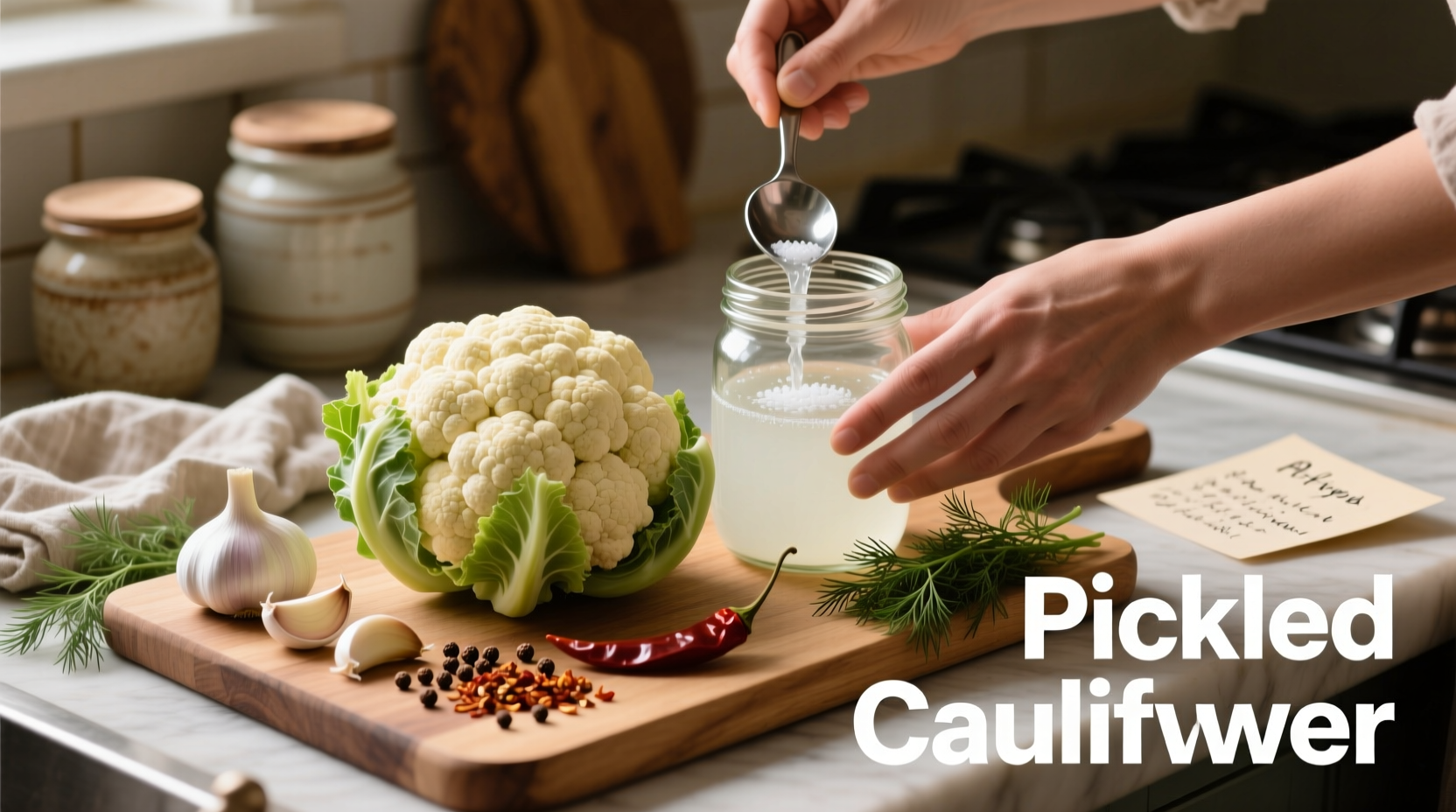Transform ordinary cauliflower into a tangy, crunchy condiment that elevates sandwiches, salads, and charcuterie boards. This foolproof method delivers consistently crisp results without special equipment, using pantry staples you likely already have. Whether you're new to food preservation or looking to expand your pickle repertoire, this guide covers every detail from brine chemistry to storage timelines.
Why Pickle Cauliflower?
Pickled cauliflower offers remarkable versatility beyond standard pickles. The florets absorb flavors beautifully while maintaining a satisfying crunch that holds up in salads and grain bowls. Unlike cucumbers, cauliflower's neutral base accepts bold spices like mustard seeds, turmeric, and chili flakes without overwhelming its natural character.
According to the National Center for Home Food Preservation, properly acidified vegetables like pickled cauliflower provide safe, shelf-stable options when processed correctly. The lactic acid fermentation process also enhances bioavailability of certain nutrients while introducing beneficial probiotics.
Essential Equipment Checklist
| Item | Why It Matters | Substitute Options |
|---|---|---|
| Mason jars with lids | Air-tight seal prevents contamination | Glass food storage containers |
| Non-reactive pot | Prevents metallic flavors in brine | Stainless steel or enamel-coated |
| Measuring cups/spoons | Ensures proper acid-salt balance | Digital kitchen scale |
| Funnel | Prevents spills during filling | Paper cone or clean plastic bottle |
Ingredient Selection Guide
The quality of your ingredients directly impacts final flavor. For best results:
- Vinegar: Use 5% acidity distilled white vinegar for classic flavor or apple cider vinegar for subtle sweetness
- Salt: Pickling salt (without anti-caking agents) prevents cloudiness - never use iodized table salt
- Spices: Whole spices like mustard seeds and coriander provide cleaner flavor than pre-ground versions
- Cauliflower: Choose dense, ivory-colored heads with tight florets - avoid any with yellowing

Step-by-Step Pickling Process
Preparation Phase (15 minutes)
- Wash cauliflower thoroughly and cut into uniform 1.5-inch florets
- Blanch in boiling water for 90 seconds to preserve crunch
- Immediately transfer to ice water bath for 2 minutes
- Sterilize jars by boiling or running through dishwasher's sanitize cycle
Brine Creation (5 minutes)
Mix 2 cups vinegar, 2 cups water, 2 tablespoons pickling salt, and 2 tablespoons sugar in a non-reactive pot. Add your spice blend - a classic combination includes 1 tablespoon mustard seeds, 1 teaspoon coriander seeds, and 2 dried chili peppers. Bring to gentle simmer (do not boil) to dissolve ingredients and release spice flavors.
Packing & Sealing (10 minutes)
- Place spice blend in bottom of each jar
- Pack cauliflower tightly leaving 1/2 inch headspace
- Pour hot brine over florets covering completely
- Remove air bubbles with chopstick
- Wipe rims clean and seal with lids
Flavor Development Timeline
Understanding the maturation process ensures perfect results:
- Day 1-2: Vinegar flavor dominates, slight crunch remains
- Day 3-4: Spices fully integrate, optimal crunch-to-tenderness balance
- Day 5-7: Complex flavor development, ideal for serving
- 1 month+: Mellowed flavors, softer texture preferred for cooking
As Antonio Rodriguez explains from professional kitchen experience: "The magic happens between days 3-5 when the vinegar's sharpness mingles with the cauliflower's natural sugars. Rushing this process sacrifices depth of flavor."
Troubleshooting Common Issues
Cloudy Brine Solutions
Cloudiness typically indicates using table salt with anti-caking agents or hard water. The FDA's Food Code specifies that pickling salt contains pure sodium chloride without additives that cause cloudiness. Always use filtered water if your tap water has high mineral content.
Soft or Mushy Texture
Over-blanching or insufficient acidity causes texture issues. Maintain proper vinegar-to-water ratio (never exceed 50% water) and limit blanching to 90 seconds. Adding 1/4 teaspoon calcium chloride per quart preserves crunch without altering flavor.
Storage Guidelines for Maximum Freshness
For shelf-stable storage:
- Process sealed jars in boiling water bath for 10 minutes
- Cool completely before storing (24 hours minimum)
- Store in dark, cool place (50-70°F / 10-21°C)
- Consume within 12-18 months for best quality
Refrigerated quick-pickles (without water bath processing) should be consumed within 3-4 weeks. Always check for signs of spoilage including bulging lids, off odors, or mold before consuming.
Creative Serving Suggestions
Elevate everyday meals with these professional chef techniques:
- Add to tuna salad for acidity without mayo overload
- Chop finely for relish on grilled fish or chicken
- Include in rice bowls for flavor contrast
- Blend with Greek yogurt for quick sandwich spread
- Roast after pickling for caramelized flavor dimension
Frequently Asked Questions
How long does pickled cauliflower last unrefrigerated?
Properly processed and sealed pickled cauliflower remains shelf-stable for 12-18 months when stored in a cool, dark place. The National Center for Home Food Preservation confirms that vinegar-based pickles maintain safety and quality within this timeframe when processed using standard water bath methods.
Can I use honey instead of sugar in pickling brine?
Yes, substitute honey for sugar at a 3:4 ratio (3/4 cup honey for 1 cup sugar) to maintain proper sweetness level. Note that honey may darken the brine slightly and add subtle floral notes. Avoid using honey in recipes requiring boiling as high heat can destroy beneficial enzymes.
Why did my pickled cauliflower turn pink?
Pink discoloration occurs when anthocyanins in cauliflower react with acidic brine. This natural pigment change is completely safe and indicates proper acidity levels. The intensity varies based on cauliflower variety and growing conditions but doesn't affect flavor or safety.











 浙公网安备
33010002000092号
浙公网安备
33010002000092号 浙B2-20120091-4
浙B2-20120091-4